差分演进算法TDOA定位
- 格式:doc
- 大小:1.73 MB
- 文档页数:58
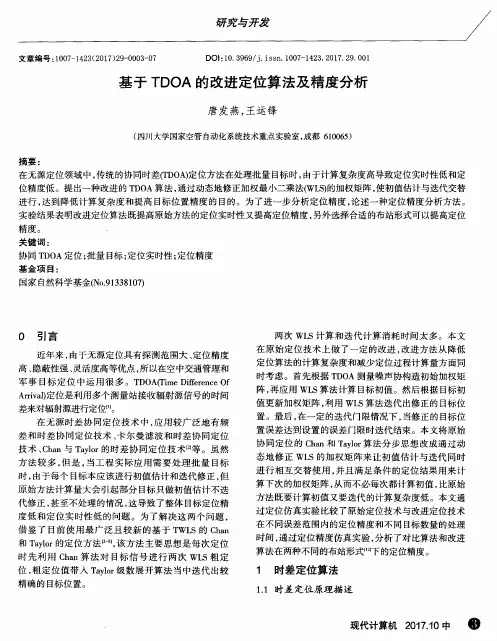

基于TDOA算法的差分UWB室内定位系统研究作者:陈小斯沈重周群张鲲郑理强来源:《现代电子技术》2018年第06期摘要:超宽带UWB定位技术在受到电磁干扰、NLOS 等情况影响时,实际定位环境变得复杂,造成实际定位精度不高、定位稳定性差。
通过借鉴差分GPS技术,以TDOA⁃UWB 室内定位技术为基础,提出差分UWB定位算法。
同时结合权重滑动平均法,研究并提出基于TDOA算法的差分UWB室内定位系统,以Hainan EVK 2.0系统作为实验平台进行相关的测试实验。
实验结果表明,基于TDOA算法的差分UWB室内定位系统能有效提高定位精度和定位稳定性,在受到外界干扰的情况下,定位误差整体降低23%。
关键词:超宽带定位; TDOA算法;差分GPS;差分UWB定位;权重滑动平均;室内定位系统中图分类号: TN953+.7⁃34 文献标识码: A 文章编号: 1004⁃373X(2018)06⁃0045⁃05Abstract: When ultra⁃wideband (UWB) positioning technology is affected by electromagnetic interference, NLOS and other conditions, the positioning environment becomes complicated, which results in low actual positioning accuracy and poor positioning stability. On the basis of the TDOA⁃UWB indoor positioning technology, a differential UWB positioning algorithm is proposed by drawing on the experience of differential GPS (DGPS) technology. Combined with the weight moving average method, a differential UWB indoor positioning system based on TDOA algorithm is studied and proposed. With the Hainan EVK 2.0 system as the experimental platform,relational testing experiments were carried out. The experimental results show that the differential UWB indoor positioning system based on TDOA algorithm can effectively improve the positioning accuracy and positioning stability, and the positioning errors are wholly reduced by 23% in the case of external interference.Keywords: UWB positioning; TDOA algorithm; differential GPS; differential UWB positioning; weighted moving average; indoor positioning system0 引言目前,室内定位技术已成为一个热点研究领域,出现了如蓝牙技术、WiFi技术、RFID (Radio Frequency Identification)技术等的室内定位技术。
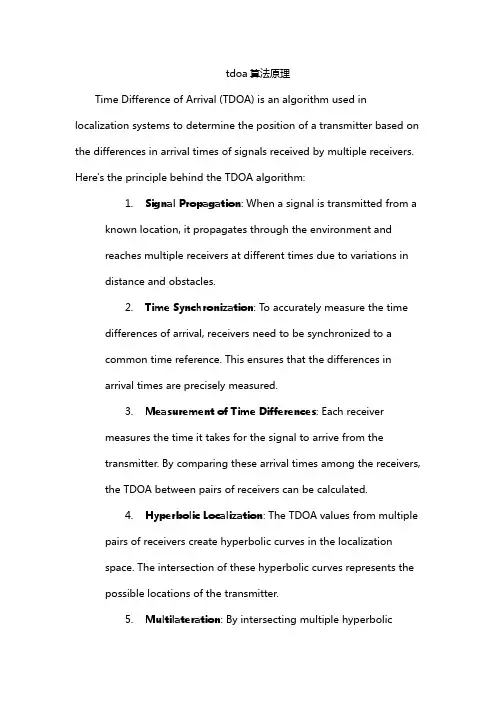
tdoa算法原理Time Difference of Arrival (TDOA) is an algorithm used in localization systems to determine the position of a transmitter based on the differences in arrival times of signals received by multiple receivers. Here's the principle behind the TDOA algorithm:1.Signal Propagation: When a signal is transmitted from aknown location, it propagates through the environment andreaches multiple receivers at different times due to variations indistance and obstacles.2.Time Synchronization: To accurately measure the timedifferences of arrival, receivers need to be synchronized to acommon time reference. This ensures that the differences inarrival times are precisely measured.3.Measurement of Time Differences: Each receivermeasures the time it takes for the signal to arrive from thetransmitter. By comparing these arrival times among the receivers, the TDOA between pairs of receivers can be calculated.4.Hyperbolic Localization: The TDOA values from multiplepairs of receivers create hyperbolic curves in the localizationspace. The intersection of these hyperbolic curves represents thepossible locations of the transmitter.5.Multilateration: By intersecting multiple hyperboliccurves, the TDOA algorithm determines the most likely positionof the transmitter. This process is known as multilateration and is used to estimate the transmitter's coordinates.6.Error Mitigation: Various factors such as signal noise,multipath propagation, and inaccuracies in time synchronization can introduce errors in TDOA measurements. Advancedalgorithms and techniques are employed to mitigate these errors and improve localization accuracy.TDOA算法原理(Principle of TDOA Algorithm):时间差到达(TDOA)是用于定位系统的一种算法,根据多个接收器接收到的信号到达时间的差异来确定发射器的位置。

摘要无线定位服务是一种有着广阔市场前景的移动增值业务,基本原理是利用现有蜂窝网络,通过对各种位置特征参数,包括到达时间(TOA)、到达时间差(TDOA)、到达方向(DOA)的测量和估计,来实现移动用户的定位。
本论文对无线通信网络中基于TDOA的无线定位技术进行了研究。
本文分析了国内外相关研究现状,给出了移动台定位的几种基本方法,并给出了TDOA定位的双曲线数学模型,分析了基于TDOA定位的Chan算法、遗传算法(GA)和差分演进算法(DE),并对其进行了计算机仿真。
仿真结果表明,三种算法各有优缺点:Chan算法定位精度较低但运算速度很快,GA算法和DE算法定位精度高但收敛时间较长。
在上述研究的基础上,本论文提出了三种新的定位算法:基于TDOA的Chan-GA算法、Chan-DE算法和Chan-IDE算法。
并在相同的仿真环境下进行比较,仿真结果表明,在保证种群数量的情况下,所提的算法性能稳定,能找到逼近全局最优点的解,相对于Chan算法精度更高,相对于以前的算法在保证收敛性能的前提下有更快的收敛速度。
关键词:移动台定位;到达时间差;遗传算法;差分演进算法;免疫算法ABSTRACTCellular wireless location service is a new mobile value-added service with a good market future. Its basic principle is to implement mobile user location through estimating characteristic parameters relative to position, including time-of-arrival (TOA), time-difference-of-arrival (TDOA), direction-of-arrival (DOA), etc. This thesis aims at the research of wireless location technology based on time-related measurements in Wireless Communication System.The thesis analyzes the domestic and foreign correlation research of present situation, and gives several essential methods of mobile location. After that, the mathematical model of TDOA hyperbolic equations is established, three location algorithms based on time-difference-of-arrival (TDOA), Chan, genetic algorithm and Differential Evolution are analyzed, and have been carried on the simulation to them. The simulation results show that all the algorithms have the advantages and disadvantages.The Chan algorithm has bad location accuracy and very quick operating speed. To the contrary, the genetic algorithm and Differential Evolution have a high accuracy and a fast convergence time.Based on the above investigation, three new location algorithms called Chan-GA algorithm, Chan-DE algorithm and Chan-IDE algorithm based on TDOA measurements are put forward. Carrying on the computer simulation to them under the same environment, the simulation results show that if the population size is big enough, the algorithm is robust and can find the coordinates. It has a higher accuracy than Chan algorithms and a faster convergence time than genetic algorithm.Key words: Mobile location; TDOA; Genetic algorithm; Differential Evolution; Immune algorithm目录第1章绪论 (1)1.1课题研究背景 (1)1.2课题研究的目的和意义 (2)1.3国内外的研究现状 (4)1.4本文的主要工作 (5)第2章移动台定位的基本方法 (7)2.1移动台定位的两种方案 (7)2.1.1基于网络的定位 (7)2.1.2基于移动台的定位 (7)2.2移动台定位技术 (8)2.2.1基于场强测量的定位方法 (8)2.2.2基于传播时间测量的定位方法 (8)2.2.3基于信号到达角度测量的定位方法 (10)2.2.4混合定位方法 (10)2.3影响移动台定位精度的主要原因 (11)2.4本章小结 (12)第3章基于TDOA定位算法的分析及仿真 (13)3.1TDOA定位的数学模型 (13)3.1.1定位问题的最小二乘(LS)表示 (13)3.1.2TDOA双曲线模型 (14)3.2TDOA定位算法——Chan算法 (15)3.3定位准确率的评价指标 (20)3.4本章小结 (21)第4章遗传算法在TDOA定位中的应用 (22)4.1遗传算法简介 (22)4.1.1遗传算法的基本原理 (22)4.1.2遗传算法的特点 (23)4.1.3遗传算法的基本流程图和主要步骤 (24)4.1.4遗传算法的基本操作 (25)4.2遗传算法在TDOA定位中的实现 (27)4.2.1TDOA双曲线定位模型 (27)4.2.2改进的遗传算法的实现 (29)4.2.3Chan-GA算法的实现 (32)4.3计算机仿真 (32)4.4本章小结 (35)第5章差分演进算法在TDOA定位中的应用错误!未定义书签。
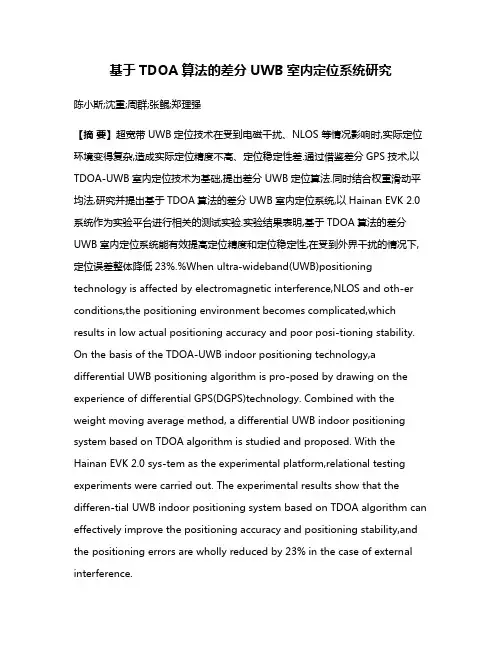
基于TDOA算法的差分UWB室内定位系统研究陈小斯;沈重;周群;张鲲;郑理强【摘要】超宽带UWB定位技术在受到电磁干扰、NLOS 等情况影响时,实际定位环境变得复杂,造成实际定位精度不高、定位稳定性差.通过借鉴差分GPS技术,以TDOA-UWB室内定位技术为基础,提出差分UWB定位算法.同时结合权重滑动平均法,研究并提出基于TDOA算法的差分UWB室内定位系统,以Hainan EVK 2.0系统作为实验平台进行相关的测试实验.实验结果表明,基于TDOA算法的差分UWB室内定位系统能有效提高定位精度和定位稳定性,在受到外界干扰的情况下,定位误差整体降低23%.%When ultra-wideband(UWB)positioning technology is affected by electromagnetic interference,NLOS and oth-er conditions,the positioning environment becomes complicated,which results in low actual positioning accuracy and poor posi-tioning stability. On the basis of the TDOA-UWB indoor positioning technology,a differential UWB positioning algorithm is pro-posed by drawing on the experience of differential GPS(DGPS)technology. Combined with the weight moving average method, a differential UWB indoor positioning system based on TDOA algorithm is studied and proposed. With the Hainan EVK 2.0 sys-tem as the experimental platform,relational testing experiments were carried out. The experimental results show that the differen-tial UWB indoor positioning system based on TDOA algorithm can effectively improve the positioning accuracy and positioning stability,and the positioning errors are wholly reduced by 23% in the case of external interference.【期刊名称】《现代电子技术》【年(卷),期】2018(041)006【总页数】5页(P45-49)【关键词】超宽带定位;TDOA算法;差分GPS;差分UWB定位;权重滑动平均;室内定位系统【作者】陈小斯;沈重;周群;张鲲;郑理强【作者单位】海南大学南海海洋资源利用国家重点实验室,海南海口570228;海南大学南海海洋资源利用国家重点实验室,海南海口570228;海南大学南海海洋资源利用国家重点实验室,海南海口570228;海南大学南海海洋资源利用国家重点实验室,海南海口570228;海南大学南海海洋资源利用国家重点实验室,海南海口570228【正文语种】中文【中图分类】TN953+.7-340 引言目前,室内定位技术已成为一个热点研究领域,出现了如蓝牙技术、WiFi技术、RFID(Radio Frequency Identification)技术等的室内定位技术。
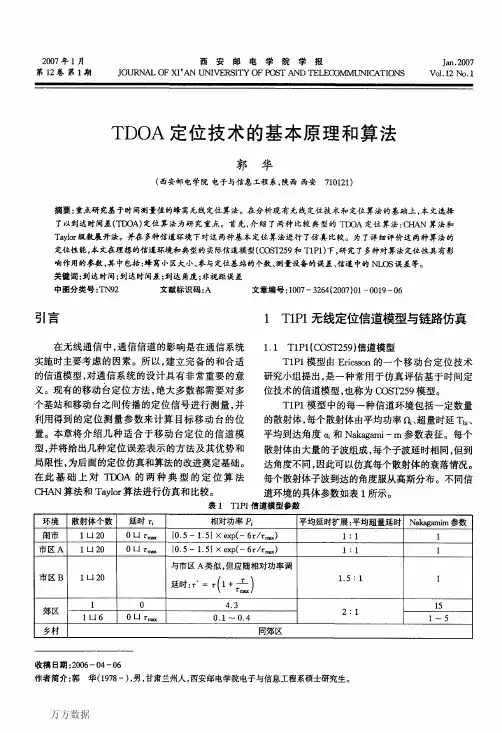
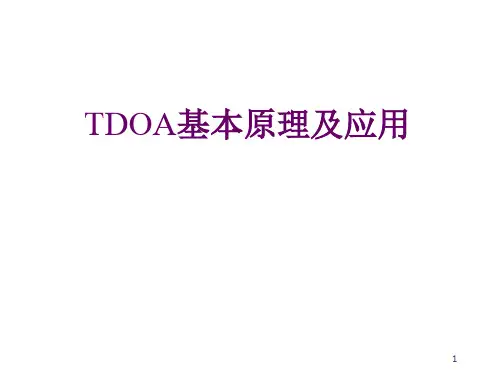
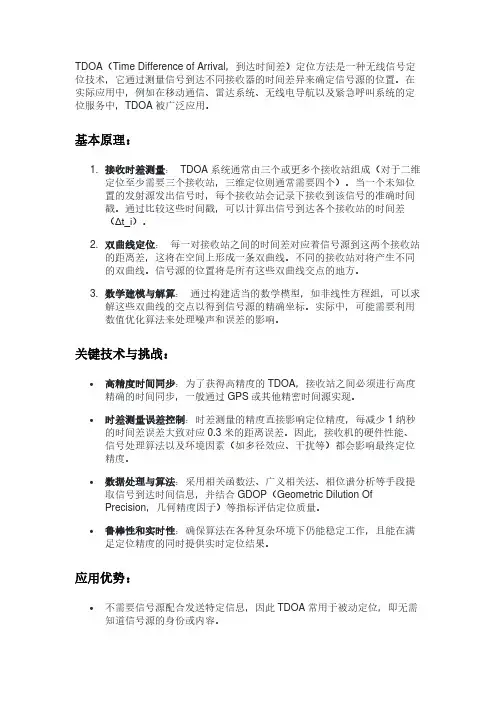
TDOA(Time Difference of Arrival,到达时间差)定位方法是一种无线信号定位技术,它通过测量信号到达不同接收器的时间差异来确定信号源的位置。
在实际应用中,例如在移动通信、雷达系统、无线电导航以及紧急呼叫系统的定位服务中,TDOA被广泛应用。
基本原理:1.接收时差测量:TDOA系统通常由三个或更多个接收站组成(对于二维定位至少需要三个接收站,三维定位则通常需要四个)。
当一个未知位置的发射源发出信号时,每个接收站会记录下接收到该信号的准确时间戳。
通过比较这些时间戳,可以计算出信号到达各个接收站的时间差(Δt_i)。
2.双曲线定位:每一对接收站之间的时间差对应着信号源到这两个接收站的距离差,这将在空间上形成一条双曲线。
不同的接收站对将产生不同的双曲线。
信号源的位置将是所有这些双曲线交点的地方。
3.数学建模与解算:通过构建适当的数学模型,如非线性方程组,可以求解这些双曲线的交点以得到信号源的精确坐标。
实际中,可能需要利用数值优化算法来处理噪声和误差的影响。
关键技术与挑战:•高精度时间同步:为了获得高精度的TDOA,接收站之间必须进行高度精确的时间同步,一般通过GPS或其他精密时间源实现。
•时差测量误差控制:时差测量的精度直接影响定位精度,每减少1纳秒的时间差误差大致对应0.3米的距离误差。
因此,接收机的硬件性能、信号处理算法以及环境因素(如多径效应、干扰等)都会影响最终定位精度。
•数据处理与算法:采用相关函数法、广义相关法、相位谱分析等手段提取信号到达时间信息,并结合GDOP(Geometric Dilution OfPrecision,几何精度因子)等指标评估定位质量。
•鲁棒性和实时性:确保算法在各种复杂环境下仍能稳定工作,且能在满足定位精度的同时提供实时定位结果。
应用优势:•不需要信号源配合发送特定信息,因此TDOA常用于被动定位,即无需知道信号源的身份或内容。
•在覆盖区域内无需信号源具备GPS接收能力,适用于无法安装GPS设备的情况。
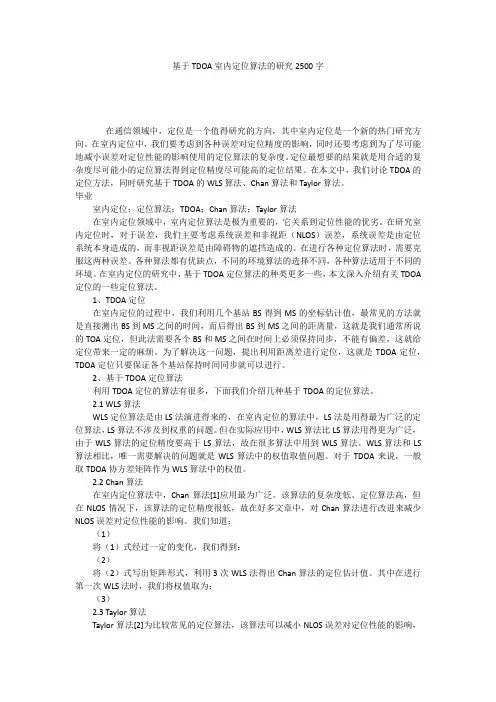
基于TDOA室内定位算法的研究2500字在通信领域中,定位是一个值得研究的方向,其中室内定位是一个新的热门研究方向。
在室内定位中,我们要考虑到各种误差对定位精度的影响,同时还要考虑到为了尽可能地减小误差对定位性能的影响使用的定位算法的复杂度。
定位最想要的结果就是用合适的复杂度尽可能小的定位算法得到定位精度尽可能高的定位结果。
在本文中,我们讨论TDOA的定位方法,同时研究基于TDOA的WLS算法、Chan算法和Taylor算法。
毕业室内定位;定位算法;TDOA;Chan算法;Taylor算法在室内定位领域中,室内定位算法是极为重要的,它关系到定位性能的优劣。
在研究室内定位时,对于误差,我们主要考虑系统误差和非视距(NLOS)误差,系统误差是由定位系统本身造成的,而非视距误差是由障碍物的遮挡造成的。
在进行各种定位算法时,需要克服这两种误差。
各种算法都有优缺点,不同的环境算法的选择不同,各种算法适用于不同的环境。
在室内定位的研究中,基于TDOA定位算法的种类更多一些,本文深入介绍有关TDOA 定位的一些定位算法。
1、TDOA定位在室内定位的过程中,我们利用几个基站BS得到MS的坐标估计值,最常见的方法就是直接测出BS到MS之间的时间,而后得出BS到MS之间的距离量,这就是我们通常所说的TOA定位,但此法需要各个BS和MS之间在时间上必须保持同步,不能有偏差,这就给定位带来一定的麻烦。
为了解决这一问题,提出利用距离差进行定位,这就是TDOA定位,TDOA定位只要保证各个基站保持时间同步就可以进行。
2、基于TDOA定位算法利用TDOA定位的算法有很多,下面我们介绍几种基于TDOA的定位算法。
2.1 WLS算法WLS定位算法是由LS法演进得来的,在室内定位的算法中,LS法是用得最为广泛的定位算法,LS算法不涉及到权重的问题。
但在实际应用中,WLS算法比LS算法用得更为广泛,由于WLS算法的定位精度要高于LS算法,故在很多算法中用到WLS算法。
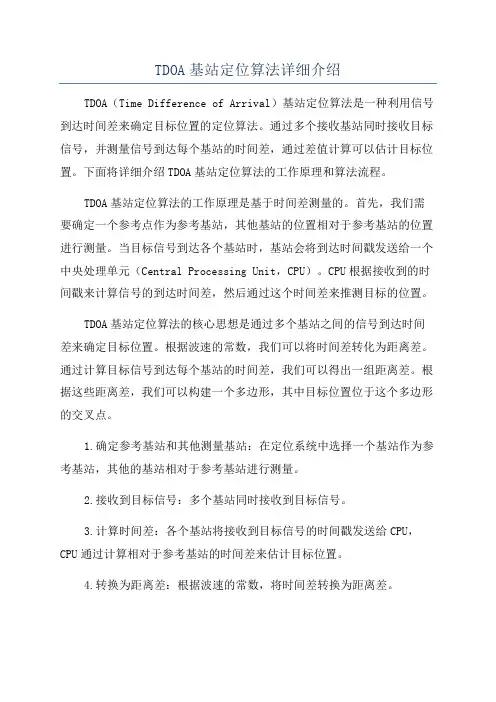
TDOA基站定位算法详细介绍TDOA(Time Difference of Arrival)基站定位算法是一种利用信号到达时间差来确定目标位置的定位算法。
通过多个接收基站同时接收目标信号,并测量信号到达每个基站的时间差,通过差值计算可以估计目标位置。
下面将详细介绍TDOA基站定位算法的工作原理和算法流程。
TDOA基站定位算法的工作原理是基于时间差测量的。
首先,我们需要确定一个参考点作为参考基站,其他基站的位置相对于参考基站的位置进行测量。
当目标信号到达各个基站时,基站会将到达时间戳发送给一个中央处理单元(Central Processing Unit,CPU)。
CPU根据接收到的时间戳来计算信号的到达时间差,然后通过这个时间差来推测目标的位置。
TDOA基站定位算法的核心思想是通过多个基站之间的信号到达时间差来确定目标位置。
根据波速的常数,我们可以将时间差转化为距离差。
通过计算目标信号到达每个基站的时间差,我们可以得出一组距离差。
根据这些距离差,我们可以构建一个多边形,其中目标位置位于这个多边形的交叉点。
1.确定参考基站和其他测量基站:在定位系统中选择一个基站作为参考基站,其他的基站相对于参考基站进行测量。
2.接收到目标信号:多个基站同时接收到目标信号。
3.计算时间差:各个基站将接收到目标信号的时间戳发送给CPU,CPU通过计算相对于参考基站的时间差来估计目标位置。
4.转换为距离差:根据波速的常数,将时间差转换为距离差。
5.构建多边形:根据距离差,将目标位置可能在的区域构建为一个多边形。
6.确定目标位置:通过求解多边形的交叉点,确定目标的最可能位置。
TDOA基站定位算法的优点是定位精度较高。
由于使用多个基站同时接收信号并计算时间差,相对于单个基站定位算法,TDOA算法能够提供更好的定位精度。
此外,TDOA算法不需要测量信号的功率信息,因此对于弱信号和噪声信号的处理也较为灵活。
然而,TDOA基站定位算法也存在一些限制。
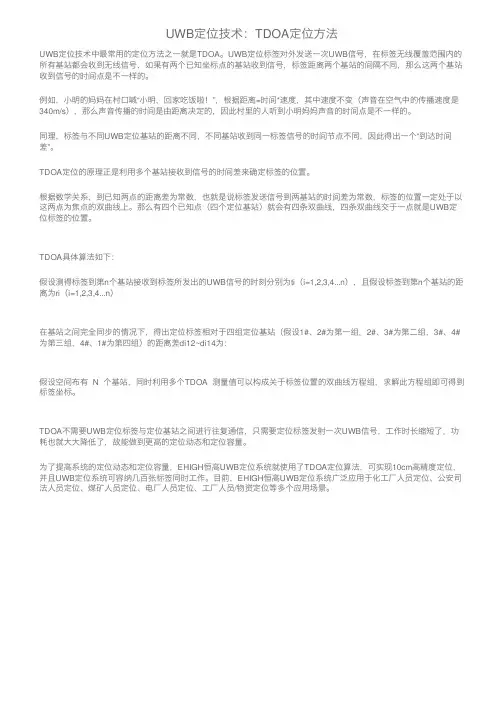
UWB定位技术:TDOA定位⽅法UWB定位技术中最常⽤的定位⽅法之⼀就是TDOA。
UWB定位标签对外发送⼀次UWB信号,在标签⽆线覆盖范围内的所有基站都会收到⽆线信号,如果有两个已知坐标点的基站收到信号,标签距离两个基站的间隔不同,那么这两个基站收到信号的时间点是不⼀样的。
例如,⼩明的妈妈在村⼝喊“⼩明,回家吃饭啦!”,根据距离=时间*速度,其中速度不变(声⾳在空⽓中的传播速度是340m/s),那么声⾳传播的时间是由距离决定的,因此村⾥的⼈听到⼩明妈妈声⾳的时间点是不⼀样的。
同理,标签与不同UWB定位基站的距离不同,不同基站收到同⼀标签信号的时间节点不同,因此得出⼀个“到达时间差”。
TDOA定位的原理正是利⽤多个基站接收到信号的时间差来确定标签的位置。
根据数学关系,到已知两点的距离差为常数,也就是说标签发送信号到两基站的时间差为常数,标签的位置⼀定处于以这两点为焦点的双曲线上。
那么有四个已知点(四个定位基站)就会有四条双曲线,四条双曲线交于⼀点就是UWB定位标签的位置。
TDOA具体算法如下:假设测得标签到第n个基站接收到标签所发出的UWB信号的时刻分别为ti(i=1,2,3,4...n),且假设标签到第n个基站的距离为ri(i=1,2,3,4...n)在基站之间完全同步的情况下,得出定位标签相对于四组定位基站(假设1#、2#为第⼀组,2#、3#为第⼆组,3#、4#为第三组,4#、1#为第四组)的距离差di12~di14为:假设空间布有N 个基站,同时利⽤多个TDOA 测量值可以构成关于标签位置的双曲线⽅程组,求解此⽅程组即可得到标签坐标。
TDOA不需要UWB定位标签与定位基站之间进⾏往复通信,只需要定位标签发射⼀次UWB信号,⼯作时长缩短了,功耗也就⼤⼤降低了,故能做到更⾼的定位动态和定位容量。
为了提⾼系统的定位动态和定位容量,EHIGH恒⾼UWB定位系统就使⽤了TDOA定位算法,可实现10cm⾼精度定位,并且UWB定位系统可容纳⼏百张标签同时⼯作。
tdoa 参数估计算法
TDOA参数估计算法是一种通过测量无线电信号到达不同监测地点的天线单元的时间差,来对发射无线电信号的发射源进行定位的算法。
以下是该算法的基本步骤:
1. 同步监测站:为了确保各个监测站的时间是同步的,可以采用GPS、有
线或无线方式来实现。
2. 测量时间差:从监测站将同一时间测量同一信号得到的数据发送至主监测站,主监测站分别计算出无线电信号达到两个监测站天线的时间差,这个时间差通常利用相关算法来计算。
3. 转换为距离差:根据时间差乘以电磁波速度,可以转换为两个监测站之间的距离差。
这样得到的是一条双曲线。
4. 定位发射源:通过三个或多个无线电监测站测得的时间差可以得到两条或多条双曲线相交,从而实现对发射源的定位。
TDOA参数估计算法的关键在于高精度同步和准确测量时间差。
同时,由于信号传播速度很快,因此需要高精度的计时设备和算法来确保定位的准确性。
以上内容仅供参考,如需更专业的解释,建议咨询信号处理或通信领域的专家或查阅相关文献资料。
基于TDOA的chan算法(定位算法)Chan算法原理TDOA(TDOA,the time differences of arrival,到达时间差),Chan算法是TDOA定位方法的一个很好用的方法。
Chan算法是非递归双曲线方程组解法,具有解析表达式解,主要特点是:在测量误差服从理想高斯分布时,它的定位精度高、计算量小,并且可以通过增加已确定点的数量来提高算法精度。
该算法的推导前提是基于测量误差为零均值高斯随机变量,对于实际环境中误差较大的测量值,比如在有非视距误差的环境下,该算法的性能会有显著下降。
二维情况下,可分为只有三个点参与定位和三个点以上参与定位。
已知坐标 ( x 1 , y1 ) , ( x2 , y 2 ) , ( x3 , y 3 ) (x_1, y_1), (x_2, y_2), (x_3, y_3) (x1,y1),(x2,y2),(x3,y3),假设第未知点的坐标是 ( x , y ) (x, y) (x,y)根据几何关系定义一下关系表达式:r i = ( x i − x ) 2 + ( y i − y ) 2 r_i =\sqrt{(x_i-x)^2+(y_i-y)^2} ri=(xi−x)2+(yi−y)2... ... ... ( 1 ) \dots\dots\dots(1) (1)r i , 1 = r i − r 1 = ( x i − x ) 2 + ( y i − y ) 2 − ( x 1 − x ) 2 + ( y 1 − y ) 2 r_{i,1}=r_i-r_1=\sqrt{(x_i-x)^2+(y_i-y)^2}-\sqrt{(x_1-x)^2+(y_1-y)^2} ri,1=ri−r1=(xi−x)2+(yi−y)2−(x1−x)2+(y1−y)2... ... ... ( 2 ) \dots\dots\dots(2) (2)根据(1)另有如下关系:先令 K i = x i 2 + y i 2K_i=x_i^2+y_i^2 Ki=xi2+yi2r i 2 = x i 2 + y i 2 = K i − 2 x i x − 2 y i y + x 2 + y 2 r_i^2=x_i^2+y_i^2=K_i-2x_ix-2y_iy+x^2+y^2 ri2 =xi2+yi2=Ki−2xix−2yiy+x2+y2 … … … ( 3 )\dots\dots\dots(3) (3)根据(2)另外有如下关系:r i 2 = ( r i , 1 + r i ) 2 r_i^2=(r_{i,1}+r_i)^2 ri2 =(ri,1+ri)2 ... ... ... ( 4 ) \dots\dots\dots(4) (4)将(3)代入(4)可推出如下关系(关键):r i , 1 2 + 2 r i , 1 r 1 = x i 2 + y i 2 − 2 x i x − 2 y i y + 2 x 1 x + 2 y 1 y − ( x 1 2 + y 1 2 ) = r i 2 − r 1 2 r_{i,1}^2+2r_{i,1}r_1=x_i^2+y_i^2-2x_ix-2y_iy+2x_1x+2y_1y-(x_1^2+y_1^2)=r_i^2-r_1^2ri,12+2ri,1r1=xi2+yi2−2xix−2yiy+2x1x+2y1y−(x12+y12 )=ri2−r12 ... ... ... ( 5 ) \dots\dots\dots(5) (5)进一步,令 x i , 1 = x i − x 1 x_{i,1}=x_i-x_1 xi,1=xi−x1,有r i , 1 2 + 2 r i , 1 r 1 = ( K i − K 1 ) − 2 x i , 1 x − 2 y i , 1 y r_{i,1}^2+2r_{i,1}r_1=(K_i-K_1)-2x_{i,1}x-2y_{i,1}y ri,12+2ri,1r1=(Ki−K1)−2xi,1x−2yi,1y这里(5)是关键一步:消除了未知数的平方项,仅保留一系列的线性方程。
基于TDOA的无线定位算法改进
刘祯;武云鹏;樊兴;王雅琴;师永平
【期刊名称】《火力与指挥控制》
【年(卷),期】2014(000)0z1
【摘要】无线定位技术广泛应用于各个行业。
首先分析了基于TDOA的Chan定位算法,针对Chan算法在测量噪声加大时定位精度下降的问题,将差分演进算法(DE)与Chan算法相结合,提出了一种Chan-DE复合算法,并通过仿真验证了Chan-DE复合算法的有效性。
【总页数】4页(P52-54,58)
【作者】刘祯;武云鹏;樊兴;王雅琴;师永平
【作者单位】北方自动控制技术研究所,太原030006;北方自动控制技术研究所,太原030006;北方自动控制技术研究所,太原030006;北方自动控制技术研究所,太原 030006;北方自动控制技术研究所,太原 030006
【正文语种】中文
【中图分类】TN915
【相关文献】
1.基于TDOA无线电定位系统的接收机要求——罗德与施瓦茨用于TDOA网络的传感器技术(一) [J], 罗德与施瓦茨(中国)有限公司
2.基于TDOA无线电定位系统的接收机要求——罗德与施瓦茨TDOA传感器的重要参数(二) [J], 罗德与施瓦茨(中国)有限公司
3.基于聚类和TDOA的无线基站定位算法研究 [J], 方焕阳;李烨
4.基于TDOA的高精度无线定位算法分析与实现 [J], 孔维炯;丁志中;方福柱
5.基于UWB的风机塔筒内无线定位算法TDOA的研究与仿真 [J], 闫馨月
因版权原因,仅展示原文概要,查看原文内容请购买。
TDOA基站定位算法详细介绍TDOA(Time Difference of Arrival)基站定位算法是一种利用时间差来实现定位的方法。
它是一种相对较简单而有效的定位算法,广泛应用于无线通信领域。
本文将详细介绍TDOA基站定位算法的原理、流程和应用。
一、原理TDOA基站定位算法的核心原理是利用不同基站接收到信号的到达时间差来计算目标物体的位置。
当目标物体发出信号时,信号会以固定的速度在空间中传播,到达不同基站的时间会有微小的差别。
根据这些时间差,可以对目标物体的位置进行估计。
二、流程1.数据采集:各个基站接收到目标物体发出的信号,并记录下到达时间。
2.时差估计:根据接收到的信号到达时间,计算不同基站之间的时间差。
常用的计算方法有互相关法和最小二乘法。
3.距离估计:利用时间差,可以计算出目标物体到不同基站的距离。
距离估计方法通常是利用信号传播速度乘以时间差。
4.定位计算:根据已知的基站位置和目标物体到不同基站的距离,可以利用三角定位法或最小二乘法等进行定位计算,得到目标物体的坐标。
5.定位结果输出:最后,将计算得到的目标物体坐标输出给应用程序或其他模块进行后续处理或显示。
三、应用1.无线通信:在移动通信网络中,可以利用TDOA算法对手机进行定位,实现手机追踪和定位服务,用于安全防护、紧急救援等方面。
2.超宽带定位:利用TDOA算法结合超宽带技术,可以实现对人员、车辆等的高精度定位,广泛应用于室内导航、智能交通等领域。
3.军事应用:TDOA算法可以应用于无线电侦察领域,对目标信号进行定位,用于军事情报收集、无线电干扰定位等。
4.航空航天:在航空航天领域,TDOA算法可以用于飞行器的定位跟踪和导航,提高航空器的安全性和准确性。
5.无人驾驶:将TDOA算法应用于无人驾驶系统中,可以提供车辆的准确位置信息,用于车辆自主导航和避障。
四、优势和不足1.精度较高:由于利用了多个基站的信息进行定位,TDOA算法通常具有比较高的定位精度。
5G UL TDOA定位算法流程随着5G技术的发展,定位算法也得到了越来越多的关注和应用。
UL TDOA(Uplink Time Difference of Arrival)定位算法作为5G中一种重要的定位技术之一,其定位精度高、定位范围广等特点,被广泛应用于室内定位、智能导航、无人驾驶等领域。
本文将结合相关理论知识,介绍5G UL TDOA定位算法的流程。
一、5G UL TDOA定位算法概述1. UL TDOA定位原理UL TDOA定位算法是利用移动终端定位的信号在不同基站之间的到达时间差来计算移动终端的位置。
通过测量信号到达不同基站的时间差,可以利用三边定位法则计算出移动终端的准确位置。
2. UL TDOA定位技术特点(1)支持高精度室内外定位UL TDOA定位技术可以实现室内外定位,且其定位精度高,能够满足高精度定位需求。
(2)支持大规模设备定位UL TDOA定位技术能够支持大规模设备同时进行定位,适用于大规模智能物联网场景。
(3)能耗低UL TDOA定位技术在进行定位过程中能耗较低,有利于延长移动终端的续航时间。
二、5G UL TDOA定位算法流程1. 数据采集移动终端首先需要向周围的多个基站发送信号,并获取各个基站接收到信号的时间戳,作为初始数据。
2. 信号传输基站接收到移动终端发送的信号后,将信号经过处理传输到定位服务器,包括信号的时间戳、信号强度等信息。
3. 信号处理定位服务器对接收到的信号进行处理,包括信号时间戳的提取、计算信号到各个基站的时间差等。
4. 定位计算基于接收到的信号数据,定位服务器利用UL TDOA定位算法进行位置计算,得出移动终端的准确位置。
5. 结果反馈定位服务器将计算出的位置信息反馈给移动终端,移动终端则可以根据获取到的位置信息进行相应的应用。
三、5G UL TDOA定位算法的优势与挑战1. 优势(1)实现高精度定位UL TDOA定位算法能够实现移动终端的高精度定位,满足各种场景下的定位需求。
下行tdoa定位原理TDOA定位原理引言:在当今的智能化时代,定位技术已经成为了人们生活中不可或缺的一部分。
而TDOA(Time Difference of Arrival)定位技术,作为一种精准的定位方式,已经得到了广泛的应用。
本文将详细介绍TDOA定位原理,以及其在实际应用中的一些特点和限制。
一、TDOA定位原理概述TDOA定位技术是一种基于时间差测量的定位方法,通过测量信号到达不同接收器的时间差,从而确定信号源的位置。
其原理基于声波、无线电波或其他信号在空间中传播的速度是已知的,因此可以通过测量信号到达不同接收器的时间差,计算出信号源的位置。
二、TDOA定位原理详解1. 接收器布局TDOA定位系统通常需要至少三个接收器来进行定位,这些接收器通常分布在不同的位置。
通过测量信号到达各个接收器的时间差,可以利用几何关系计算出信号源的位置。
2. 时间差测量TDOA定位系统中,时间差测量是关键步骤。
当信号源发出信号时,信号会以一定的速度传播到各个接收器。
由于距离不同,信号到达各个接收器的时间会有所差异。
通过测量这些时间差,可以计算出信号源的位置。
3. 定位计算基于时间差测量的数据,可以利用三角定位或其他数学模型计算出信号源的位置。
通过将时间差转换为距离差,再利用几何关系,可以得到信号源所在的坐标。
三、TDOA定位的特点和限制1. 精准度高相比其他定位技术,TDOA定位具有较高的精准度。
通过精确测量信号到达时间差,可以实现高精度的定位,满足各种应用场景的需求。
2. 适用范围广TDOA定位技术可以应用于不同的信号类型,包括声波、无线电波等。
因此,它可以广泛应用于通信、导航、救援等领域。
3. 多路径效应对定位精度的影响在实际应用中,TDOA定位技术受到多路径效应的影响。
多路径效应是指信号在传播过程中经历反射、折射等现象,导致信号到达接收器的时间差发生变化。
这会对定位精度产生一定的影响,需要通过算法和技术手段进行补偿。
摘要无线定位服务是一种有着广阔市场前景的移动增值业务,基本原理是利用现有蜂窝网络,通过对各种位置特征参数,包括到达时间(TOA)、到达时间差(TDOA)、到达方向(DOA)的测量和估计,来实现移动用户的定位。
本论文对无线通信网络中基于TDOA的无线定位技术进行了研究。
本文分析了国内外相关研究现状,给出了移动台定位的几种基本方法,并给出了TDOA定位的双曲线数学模型,分析了基于TDOA定位的Chan算法、遗传算法(GA)和差分演进算法(DE),并对其进行了计算机仿真。
仿真结果表明,三种算法各有优缺点:Chan算法定位精度较低但运算速度很快,GA算法和DE算法定位精度高但收敛时间较长。
在上述研究的基础上,本论文提出了三种新的定位算法:基于TDOA的Chan-GA算法、Chan-DE算法和Chan-IDE算法。
并在相同的仿真环境下进行比较,仿真结果表明,在保证种群数量的情况下,所提的算法性能稳定,能找到逼近全局最优点的解,相对于Chan算法精度更高,相对于以前的算法在保证收敛性能的前提下有更快的收敛速度。
关键词:移动台定位;到达时间差;遗传算法;差分演进算法;免疫算法ABSTRACTCellular wireless location service is a new mobile value-added service with a good market future. Its basic principle is to implement mobile user location through estimating characteristic parameters relative to position, including time-of-arrival (TOA), time-difference-of-arrival (TDOA), direction-of-arrival (DOA), etc. This thesis aims at the research of wireless location technology based on time-related measurements in Wireless Communication System.The thesis analyzes the domestic and foreign correlation research of present situation, and gives several essential methods of mobile location. After that, the mathematical model of TDOA hyperbolic equations is established, three location algorithms based on time-difference-of-arrival (TDOA), Chan, genetic algorithm and Differential Evolution are analyzed, and have been carried on the simulation to them. The simulation results show that all the algorithms have the advantages and disadvantages.The Chan algorithm has bad location accuracy and very quick operating speed. To the contrary, the genetic algorithm and Differential Evolution have a high accuracy and a fast convergence time.Based on the above investigation, three new location algorithms called Chan-GA algorithm, Chan-DE algorithm and Chan-IDE algorithm based on TDOA measurements are put forward. Carrying on the computer simulation to them under the same environment, the simulation results show that if the population size is big enough, the algorithm is robust and can find the coordinates. It has a higher accuracy than Chan algorithms and a faster convergence time than genetic algorithm.Key words: Mobile location; TDOA; Genetic algorithm; Differential Evolution; Immune algorithm目录第1章绪论 (1)1.1课题研究背景 (1)1.2课题研究的目的和意义 (2)1.3国内外的研究现状 (4)1.4本文的主要工作 (5)第2章移动台定位的基本方法 (7)2.1移动台定位的两种方案 (7)2.1.1基于网络的定位 (7)2.1.2基于移动台的定位 (7)2.2移动台定位技术 (8)2.2.1基于场强测量的定位方法 (8)2.2.2基于传播时间测量的定位方法 (8)2.2.3基于信号到达角度测量的定位方法 (10)2.2.4混合定位方法 (10)2.3影响移动台定位精度的主要原因 (11)2.4本章小结 (12)第3章基于TDOA定位算法的分析及仿真 (13)3.1TDOA定位的数学模型 (13)3.1.1定位问题的最小二乘(LS)表示 (13)3.1.2TDOA双曲线模型 (14)3.2TDOA定位算法——Chan算法 (15)3.3定位准确率的评价指标 (20)3.4本章小结 (21)第4章遗传算法在TDOA定位中的应用 (22)4.1遗传算法简介 (22)4.1.1遗传算法的基本原理 (22)4.1.2遗传算法的特点 (23)4.1.3遗传算法的基本流程图和主要步骤 (24)4.1.4遗传算法的基本操作 (25)4.2遗传算法在TDOA定位中的实现 (27)4.2.1TDOA双曲线定位模型 (27)4.2.2改进的遗传算法的实现 (29)4.2.3Chan-GA算法的实现 (32)4.3计算机仿真 (32)4.4本章小结 (35)第5章差分演进算法在TDOA定位中的应用错误!未定义书签。
5.1差分演进算法简介 (36)5.1.1差分演进算法的基本原理 (36)5.1.2差分演进算法的特点 (37)5.1.3差分演进算法的优点 (38)5.1.4差分演进算法的流程 (38)5.1.5差分演进算法的参数选取 (38)5.2差分演进算法在TDOA定位中的实现 (39)5.2.1差分演进算法的实现 (36)5.2.2Chan-DE算法的实现 (40)5.3计算机仿真 (41)5.4本章小结 (45)第6章基于CHAN-IDE的TDOA定位技术 (35)6.1免疫差分算法简介 (36)6.1.1免疫差分算法的基本原理 (36)6.1.2免疫差分算法的基本流程图 (37)6.2基于Chan-IDE算法的TDOA定位技术 (39)6.3计算机仿真 (50)6.4本章小结 (54)结论······················································································错误!未定义书签。
参考文献 ············································································错误!未定义书签。
致谢······················································································错误!未定义书签。